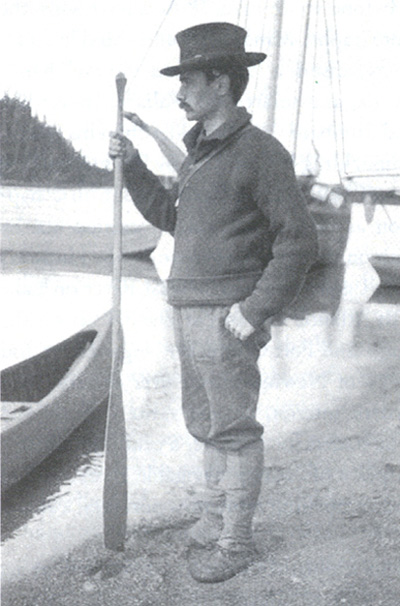Inventing Mina Benson Hubbard: From her 1905 Expedition
across Labrador to her 2005 Centennial (and Beyond)
This article is reprinted with permission
from Nordlit 22 (August 2007): 49-69. It has been
revised.
In November 1905, Mina Benson Hubbard recorded in her expedition
diary that she had "accomplished all that [she] started
for."[1] But
she had not quite accomplished everything she wanted to do, and the
expedition she had successfully completed would never leave her mind; it
had changed her, made her over from a genteel wife and widow into an
explorer and an author. Even before she began her journey, Mina (as I
call her now after my long association with her) knew she wanted to make
maps, take photographs, and write a book. She started her book while
still in Labrador waiting for the supply ship that would take her back
to civilization, and as she confided to her diary on August 31st, 1905:
"Writing to-day. Slow. Hard to decide what to write about . . . wish I
knew a bit better what public is interested in."
I have begun my discussion with these brief snippets of Mina
speaking privately in her own voice because this is about as
close as we can now get to the woman who lived at the turn of the last
century. When I began my work to prepare a new edition of her 1908
classic, A Woman's Way Through Unknown Labrador, I knew I wanted
to do my best to recover this woman, but I also quickly realized that
the task was impossible and that what I would actually end up doing was
to invent a person I call my Mina. But before I say more
about this process of invention, I must provide some biographical
background about the woman and her expedition and some factual
information about Labrador.
Mina Benson was born in 1870 into a
comfortable Irish Protestant family in southern Ontario, Canada. She
grew up on the family farm with her seven siblings, and as a young woman
she had already developed an appreciation for the outdoors and a strong
sense of independence. She left Canada for New York City to train as a
nurse, a move that was not common for women of her class and
period; however, nursing was, like teaching, an acceptable profession
for an unmarried woman. It was there that she met her first husband,
Leonidas Hubbard, Jr. Both she and Leonidas enjoyed canoeing and
camping, recreation activities that were becoming popular at the time,
but Leonidas had more ambitious plans. He had decided to lead an
expedition into one of the last unknown (to white explorers), unmapped,
and unphotographed areas of North America—the vast interior, northern
territory of Labrador—so that he could write about his adventure (see
Illustration 1). Sadly, he starved to death on his 1903 expedition, which was
a miserable failure in many ways, but his intrepid guide, George Elson,
made it to the nearest settlement for help and was able to save himself
and the third man on the expedition, Dillon Wallace.

Illustration 1 Leonidas Hubbard, Jr. on the shore of Grand
Lake at Northwest River, Labrador, July 1903, prior to embarking on his
ill-fated expedition.
Mina and Leonidas
had only been married for a few years; they were deeply in love; and she
was left behind waiting for news that took many months to reach her.
When it did, she was devastated by her husband's death. To make matters
worse, Dillon Wallace quickly published his account of the expedition.
Mina was outraged by his portrayal of her beloved Laddie and immediately
decided to mount her own expedition—the second Hubbard Expedition—so she
could complete his work and rescue his reputation.[2]However, her
husband's family was violently opposed to her plans; Wallace, who also
planned a second expedition, was hostile; and as soon as the press of
the day learned about her expedition they went berserk—but I will get to
these early 20th century papparazzi in due course.
Page: 1 | 2 | 3 | 4 | 5 | 6 | 7
Next page
|